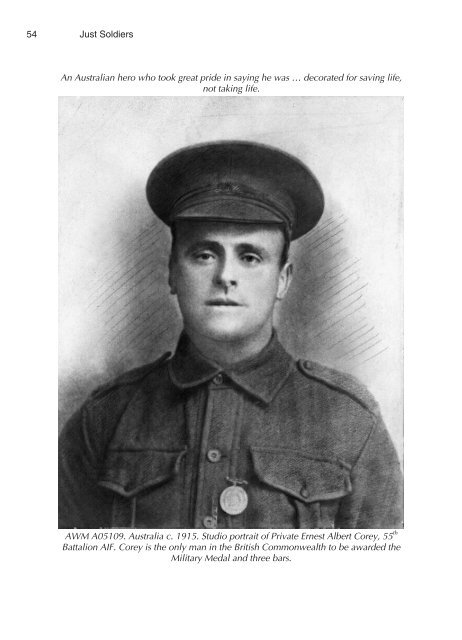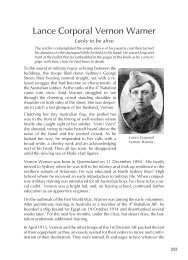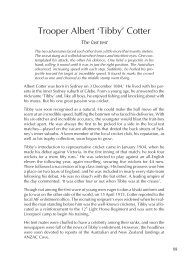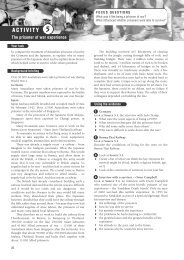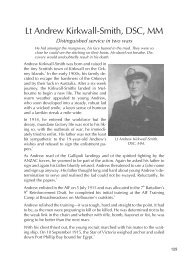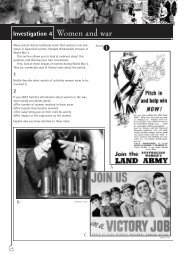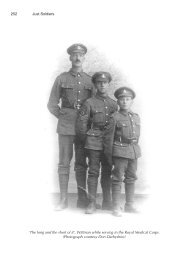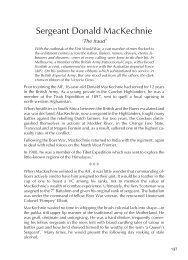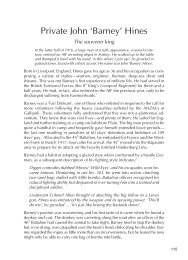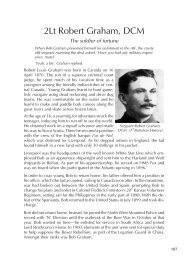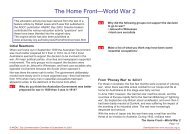Corporal Ernest Corey, MM
Corporal Ernest Corey, MM
Corporal Ernest Corey, MM
You also want an ePaper? Increase the reach of your titles
YUMPU automatically turns print PDFs into web optimized ePapers that Google loves.
54 Just Soldiers<br />
An Australian hero who took great pride in saying he was … decorated for saving life,<br />
not taking life.<br />
AWM A05109. Australia c. 1915. Studio portrait of Private <strong>Ernest</strong> Albert <strong>Corey</strong>, 55 th<br />
Battalion AIF. <strong>Corey</strong> is the only man in the British Commonwealth to be awarded the<br />
Military Medal and three bars.
<strong>Corporal</strong> <strong>Ernest</strong> <strong>Corey</strong>, <strong>MM</strong><br />
One of a kind<br />
The stretcher-bearer crawled to the wounded Digger. Assessing the situation,<br />
he grabbed the man’s thumb and rammed it into the gaping bullet<br />
hole in his leg to stem the bleeding while he ripped open a shell dressing.<br />
The whistle of the incoming round pierced the air. Both men instinctively<br />
flattened their faces into the ground as the projectile exploded nearby,<br />
showering them with mud and debris. The stretcher-bearer slowly raised<br />
his upper body and shook his head as he took stock of his surroundings. He<br />
had survived unscathed, but the explosion had been too close for his patient.<br />
Without further ado, he collected his medical haversack and crawled<br />
away in search of another man in need of help.<br />
<strong>Ernest</strong> Albert <strong>Corey</strong> was born in December 1891 at Green Hills, a small town<br />
nestled in the shadow of the Snowy Mountains. 1 A lively lad, he grew up as one<br />
of eight children born to the family. On leaving school, he sought employment<br />
as a labourer in the surrounding district. He was a hard worker and, although<br />
short in stature, he soon developed a powerful, muscular physique.<br />
In early 1916, <strong>Corey</strong> read with interest the reports of the heroic accomplishments<br />
of the Australian soldiers at Gallipoli and their successful withdrawal from<br />
the Peninsula some eight months later. However, what caught his interest the<br />
most emanated from the pubs and shops that were abuzz with talk of a recruiting<br />
march to Goulburn. Here was his opportunity to be part of the action.<br />
<strong>Corey</strong> looked proudly at the banner emblazoned with the words ‘Men from<br />
Snowy River’ under which the volunteers would march. As they wound their<br />
way through the Southern Tablelands, more and more recruits swelled their<br />
ranks as they passed through one small country town after another. 2<br />
On enlistment, <strong>Corey</strong> was allocated to the 55 th Battalion as a rifleman. The battalion<br />
had been raised in Egypt in February 1916 as part of the expansion of the<br />
AIF—half the recruits were Gallipoli veterans, the other half were fresh reinforcements<br />
from Australia. Most of the new recruits, like Ernie, were from New<br />
South Wales. The training was tough and demanding, but Ernie was more than<br />
equal to the task and it was a fit, keen soldier who strode up the gangway of the<br />
troopship Port Sydney en route to England. 3<br />
<strong>Corey</strong>’s first eight weeks in England were spent at the training camp on Salisbury<br />
Plain. The local towns and villages accepted the cocky Diggers with open arms<br />
when short leave from the camp was either granted or taken. Then one night, the<br />
platoon sergeant gave the order they’d all been waiting for. ‘Pack your kit, lads.<br />
We leave for France tomorrow.’<br />
55
56 Just Soldiers<br />
On his arrival at the battalion position on the Western Front in early 1917, Ernie<br />
was allocated to C Company where he learnt of the forthcoming attack on the<br />
fortified village of Doignies, a key outpost of the Hindenburg Line. 4<br />
Creeping forward in the predawn darkness, the Australians succeeded in taking<br />
the Germans by surprise. As the 56 th Battalion stormed the village, the 55 th took<br />
up their planned positions beyond the eastern and southern outskirts—ready to<br />
cut the Germans down as they tried to effect their withdrawal. The town fell, the<br />
Australians suffering very few casualties. 5<br />
As he sat in the trenches that night, Ernie contemplated his first taste of action.<br />
He was rather surprised at how easy it had been and not at all what he had expected.<br />
But his view of armed conflict would soon change, as the horrors of war<br />
became a reality the next time he went into action.<br />
In May, his brigade was in the thick of fighting around Queant. Casualties were<br />
heavy and the stretcher-bearers were pushed to the limit. Volunteers were called<br />
to assist with the retrieval of the wounded, and without hesitation Ernie put up<br />
his hand. For 17 hours nonstop he roamed no man’s land, bringing in one<br />
wounded man after another. 4<br />
On one of these forays, he encountered two Germans who were treating an Australian<br />
casualty. The startled Germans stood back in amazement as the tough little<br />
Digger approached them without a hint of fear or hesitation. Then, under<br />
their very noses, he gathered up the wounded Australian and headed back towards<br />
his own lines, while the confounded Germans simply looked on in<br />
bewilderment. 2<br />
Following this battle, the 55 th went into reserve trenches for a brief rest. As he sat<br />
on an ammo box savouring his first hot drink in days, Ernie received notification<br />
that he had been awarded the Military Medal. 6<br />
He asked to be allowed to continue as a stretcher-bearer and, in view of the<br />
mounting casualties, his request was granted. He showed the greatest care and<br />
compassion when treating casualties, but his method of transporting them was<br />
rather unorthodox, particularly for someone of his stature. He chose to carry<br />
them under his arms rather than use the traditional method of evacuation by<br />
stretcher. 7<br />
In September of that year, the 55 th was engaged in combat at Polygon Wood. Casualties<br />
were heavy, and <strong>Corey</strong>, as always, was in the thick of things. Many<br />
wounded Diggers lived to see another day, thanks to the cool, calm efficiency of<br />
this courageous man. As he saw a soldier fall, <strong>Corey</strong> would calmly crawl forward,<br />
through the barrage of machine-gun and artillery fire, until he reached his<br />
patient. After administering any necessary first aid, he would pick the man up<br />
under one arm and run the gauntlet of fire to a safer position. Once he knew the<br />
wounded Digger was in safe hands, he would return to the battlefield.
<strong>Corporal</strong> <strong>Ernest</strong> <strong>Corey</strong>, <strong>MM</strong> 57<br />
Elements of the citation for the bar to his Military Medal said it all. ‘…showed<br />
great courage, devotion to duty and untiring energy during the attack. Throughout<br />
the whole operation he set a fine example of bravery and coolness to all<br />
ranks. 6<br />
The pocket dynamo was provided a brief respite when he was chosen to represent<br />
his battalion in the Independence Day March through Paris—providing an<br />
opportunity to also enjoy eight days of ‘wine, women and song’ in the French<br />
capital.<br />
On 1 September 1918, the 55 th was involved in heavy fighting on the outskirts of<br />
Peronne. Ernie was kept busy, crawling out to no man’s land and repeatedly<br />
dragging the wounded to the safety of a shell hole. There he would stabilise the<br />
bleeding then call forward the stretcher-bearers. He seemed oblivious to the barrage<br />
of fire that surrounded him, and the Diggers watched in awe as the enemy<br />
machine-gun bullets seemed to dance around him.<br />
In part, the citation for the second bar to his Military Medal reads …His careful<br />
handling of the wounded and his knowledge of first-aid helped greatly to relieve<br />
their sufferings.<br />
At the end of September 1918, the Allied forces faced the apparently impregnable<br />
Hindenburg Line. The men were confronted by a visually daunting scene of<br />
seemingly endless bands of barbed wire and pillboxes shielding deadly<br />
machine-guns.<br />
Ernie, now a corporal, had a bad feeling about this one. As the Allied barrage<br />
rolled forward, the Diggers rose from their line and advanced toward the enemy<br />
positions. Suddenly, the German artillery opened up, catching the Australians in<br />
the open. Men scattered to the safety of the shell holes, but many of the wounded<br />
lay where they fell. Ernie spied his company commander lying in an exposed position,<br />
trying to control the flow of blood from the stump that was once his leg.<br />
‘I’ll get him’, Ernie shouted as he ran forward in the direction of the wounded officer.<br />
Scurrying from shell hole to shell hole, he crossed the open ground, crawling<br />
the last 50 metres or so to reach the officer’s side. <strong>Corey</strong> wasted no time<br />
applying preliminary first-aid to the man’s shattered leg.<br />
Suddenly, a burst of machine-gun fire ripped into <strong>Corey</strong>’s body, followed by a<br />
shell burst close by, which blew the medical haversack from his grasp. As Ernie<br />
gathered his wits about him, the officer crawled to retrieve the haversack, holding<br />
the stump of his shattered leg in the air as he went. He recovered the satchel<br />
and threw it back to <strong>Corey</strong> to enable him to dress the gaping wound in his thigh.<br />
Both men knew they had to move before they became victims of more incoming<br />
fire. Helping each other to their feet, they stumbled, crawled and scrambled<br />
back to the safety of their own trenches. 7
58 Just Soldiers<br />
As he lay in his hospital bed, <strong>Corporal</strong> Ernie <strong>Corey</strong> learnt he had been awarded a<br />
third bar to his Military Medal. He was still in hospital when the Armistice was<br />
declared. 6<br />
Ernie <strong>Corey</strong> was repatriated to Australia and discharged as medically unfit in<br />
June 1919. 1 He returned to the Cooma area and found work as a rabbit trapper.<br />
In 1922, he packed up and moved to Canberra, where he took on a variety of<br />
jobs.<br />
On 23 September 1941, <strong>Corey</strong> again offered his services to his country. 8 He was<br />
allocated 1 to 2 Garrison Battalion, which was tasked with guarding the vital Port<br />
Kembla steelworks. Ernie served with distinction for the next two-and-a-half<br />
years until his poor health resulted in his being discharged.<br />
He returned to his home in Canberra and life as a civilian. In the 1950s, his<br />
health began deteriorating. By the 60s, he was no longer able to look after himself<br />
and was forced to move into a nearby nursing home. Though crippled with<br />
arthritis and confined to a wheelchair, Ernie retained a keen wit. 7 He spent many<br />
hours gazing longingly at the snow-capped peaks of the distant mountains. One<br />
can only surmise that the view evoked memories of his long-gone childhood.<br />
The quietly spoken hero of so many battles died in August 1972.<br />
Today, Ernie <strong>Corey</strong>’s medals are proudly displayed in the Australian War Memorial’s<br />
Hall of Valour. He is the only soldier in the British Commonwealth to be<br />
awarded the Military Medal four times.<br />
Notes<br />
1 National Archives of Australia: B2455, WW1 Service Records, 2143 <strong>Corporal</strong> EA <strong>Corey</strong>.<br />
2 P Kelly, Albert <strong>Corey</strong> <strong>MM</strong> and 3 Bars - the Unassuming Hero, Article, Date Unknown.<br />
3 AWM 8, Unit Embarkation Nominal Rolls, 55th Battalion AIF, 1914–1918 War.<br />
4 Coulthard-Clark, CD,(Ed) The Diggers : makers of the Australian military tradition, Melbourne University Press,<br />
1993.<br />
5 Bean, CEW, The Official History of Australia in the War of 1914–1918, Volume IV, Australian War Memorial,<br />
Canberra, 1936<br />
6 AWM 28, Recommendation Files for Honours and Awards, AIF, 1914–1918 War<br />
7 Army Newspaper, June 1971<br />
8 National Archives of Australia , WW2 Service Records, N280612 Private EA <strong>Corey</strong>


